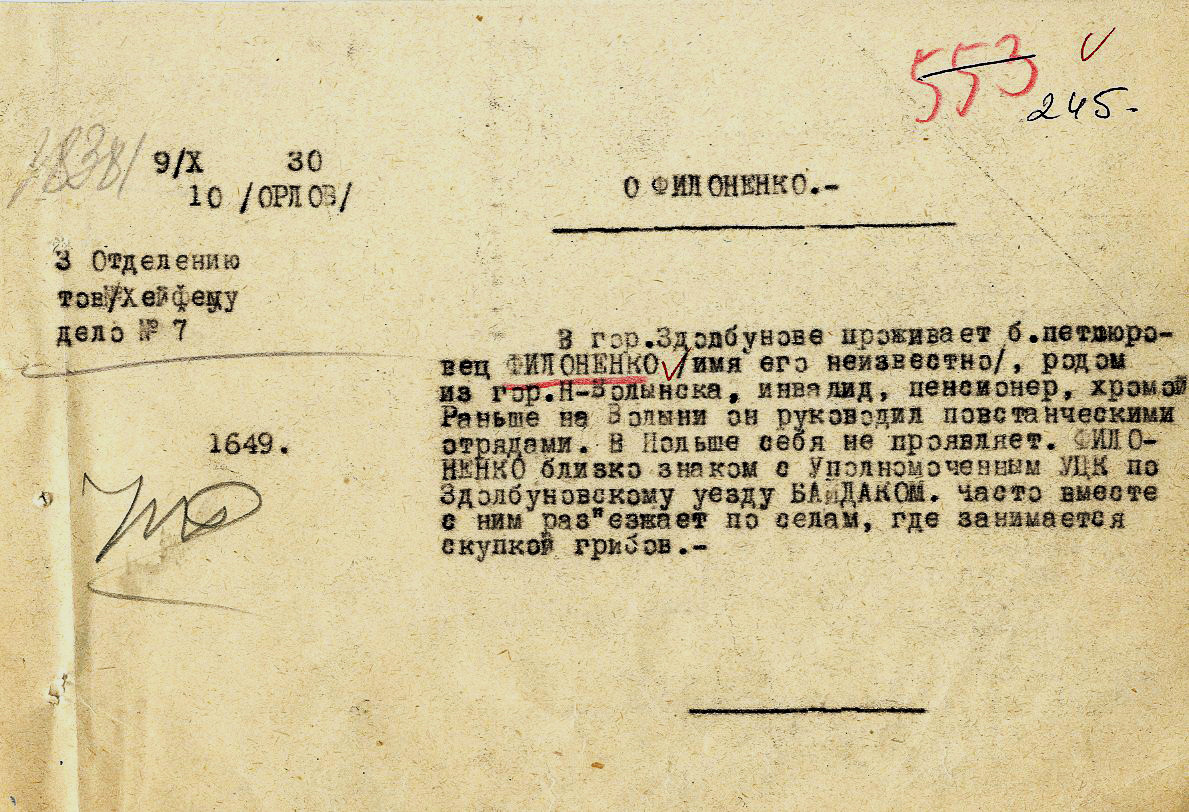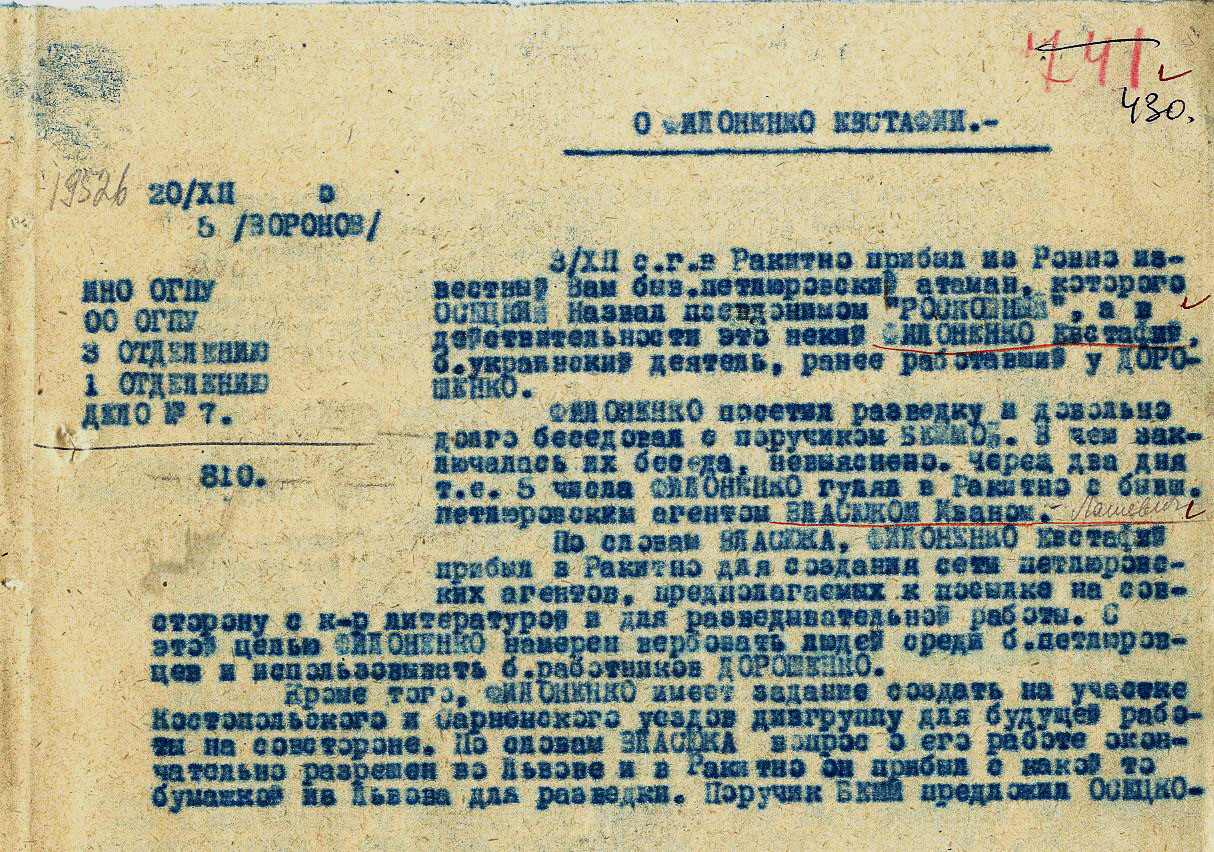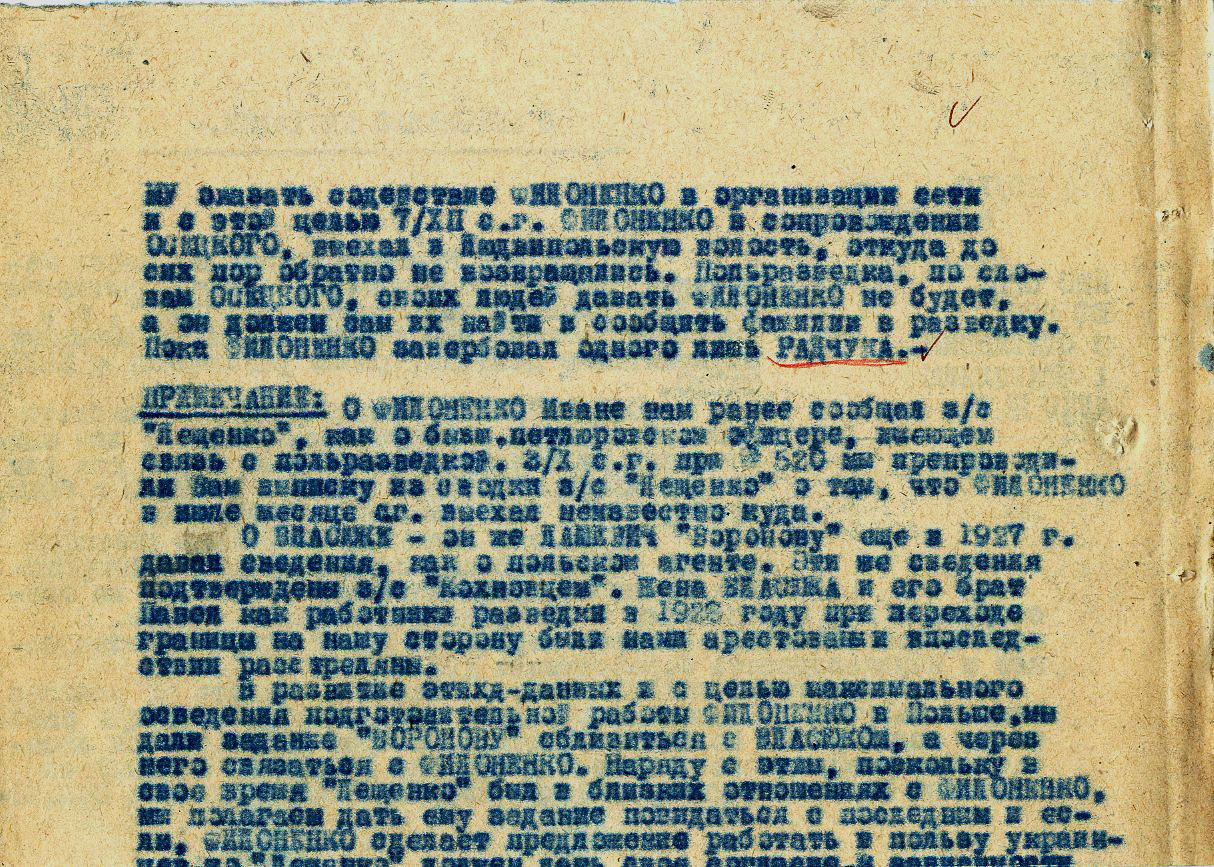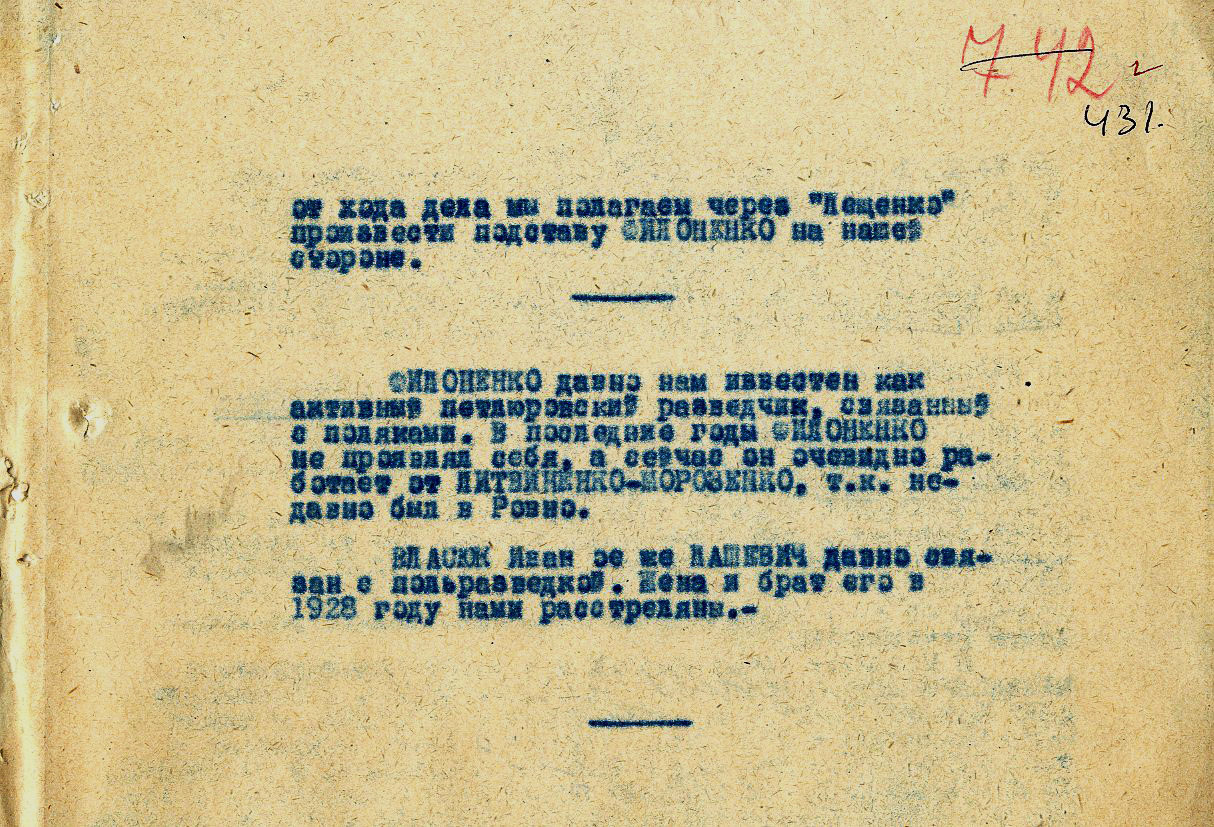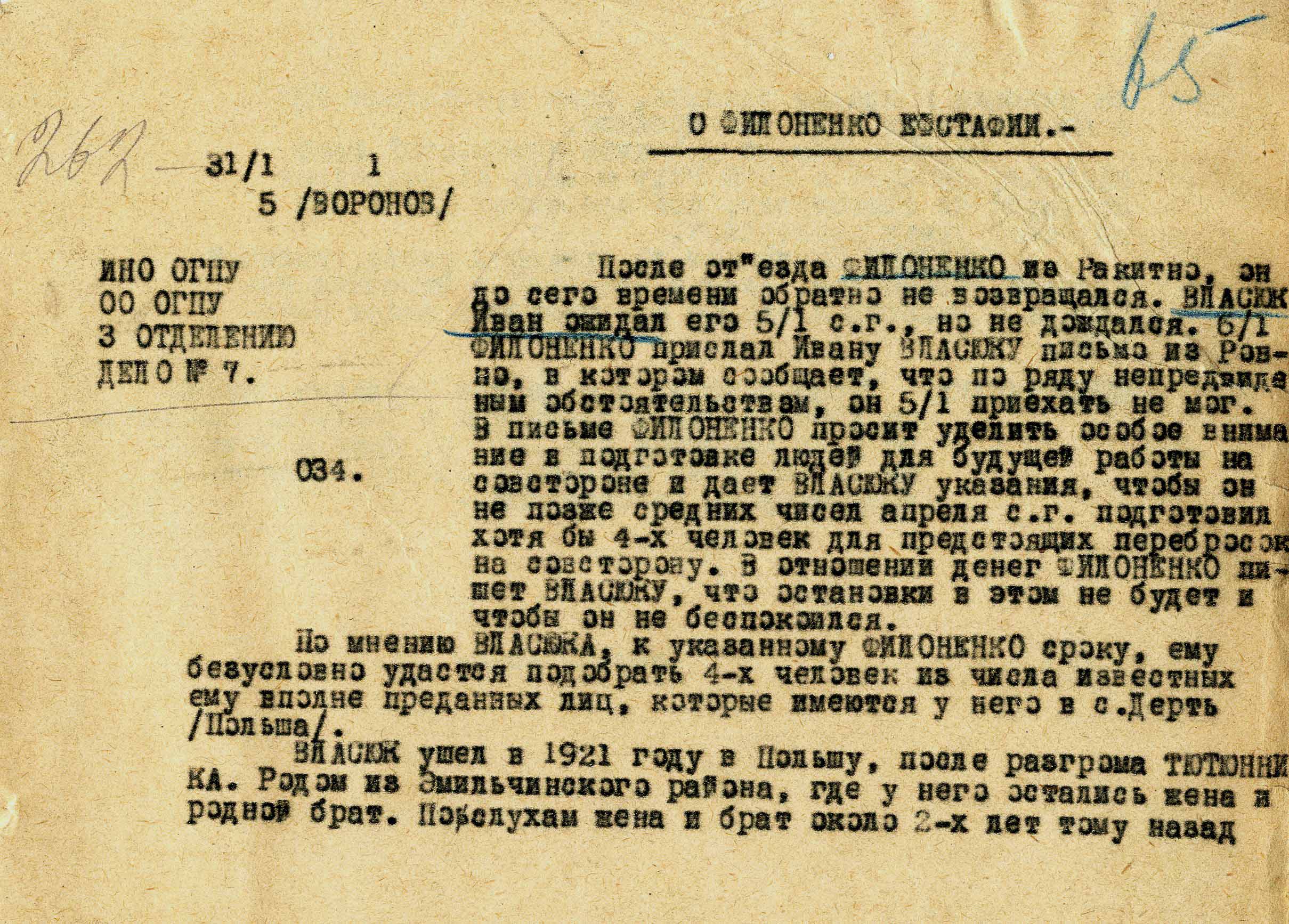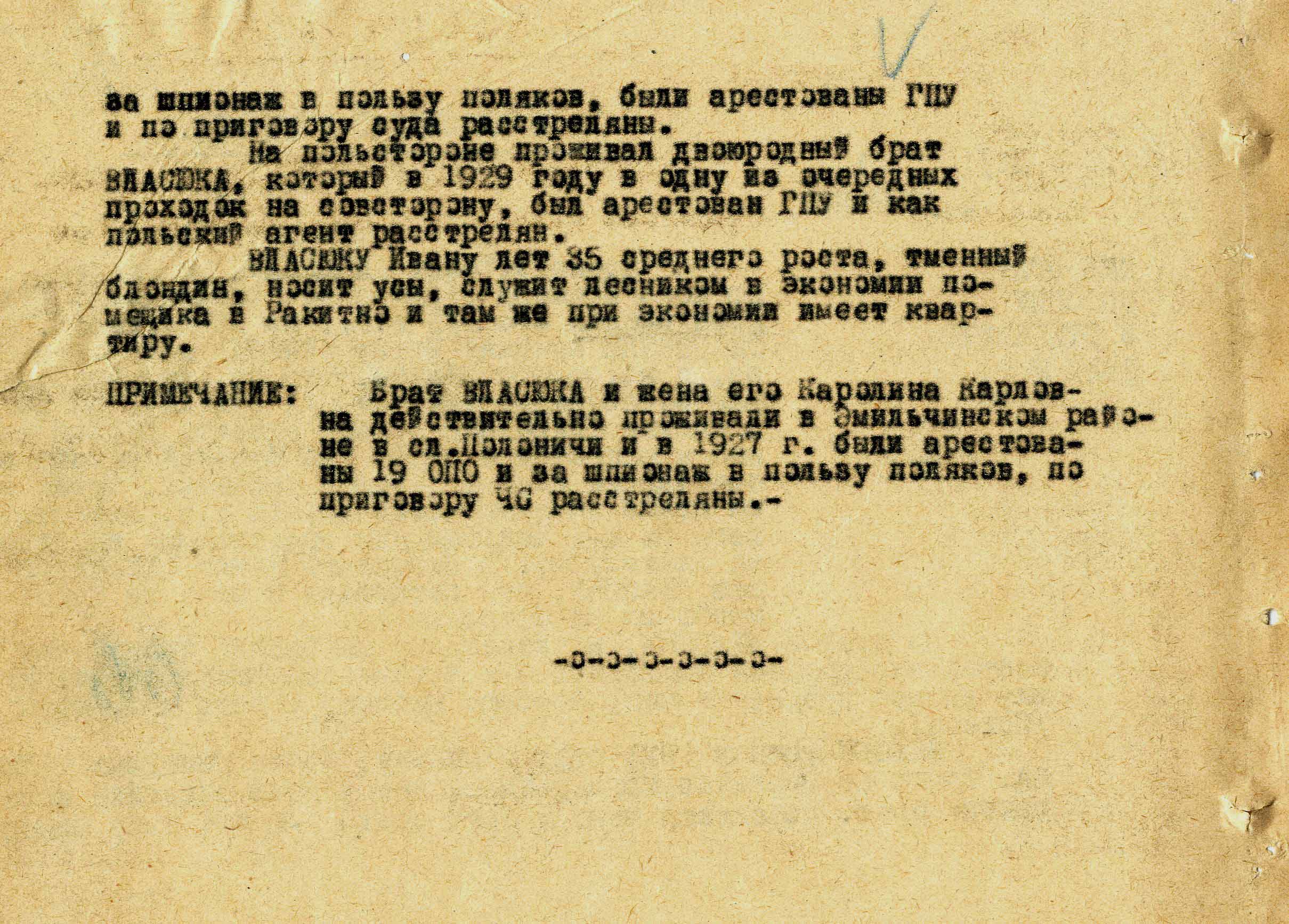Petro Filonenko. On the Instructions of Insurgent Intelligence
1/23/2025
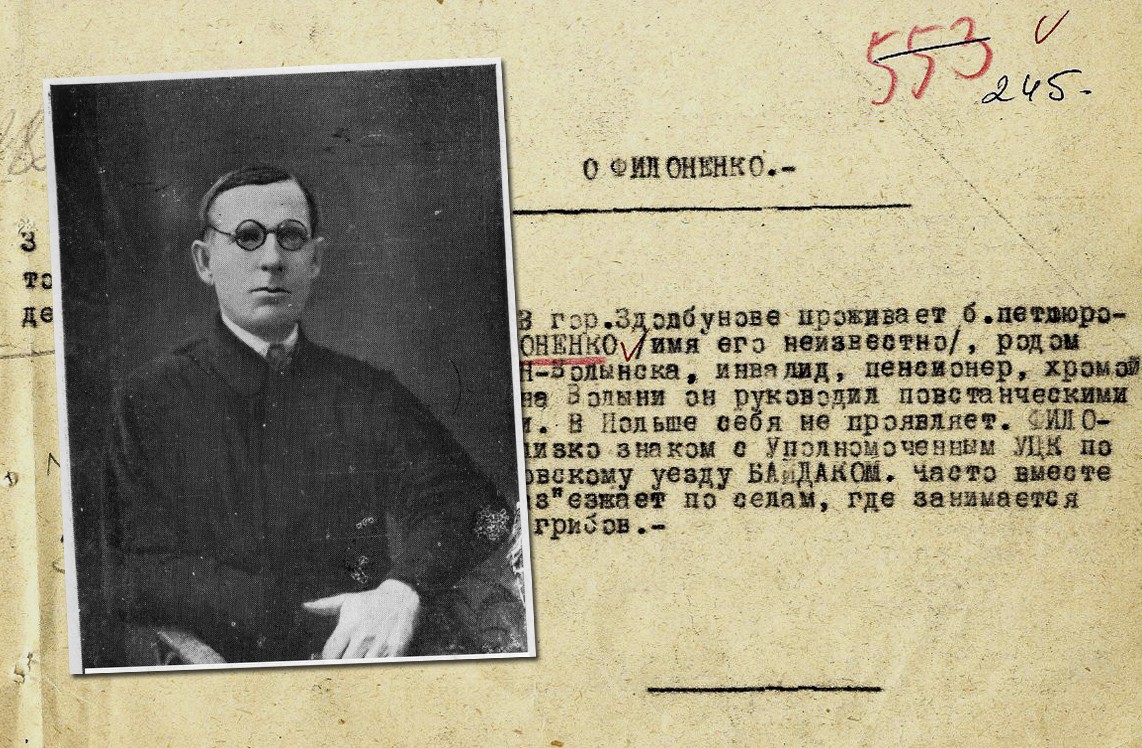
The archival documents of the Intelligence, relating to the activities of the Partisan Insurgent Staff of the State Center of the UPR in exile, headed by Khorunzhyi General Yurko Tiutiunnyk, repeatedly mention Petro Filonenko as an insurgent Otaman and intelligence officer. It is pointed out that he was an extremely brave starshyna (senior officer – Transl.), who, on the instructions of the Staff, more than once crossed the Polish-soviet border with his unit and defeated the red army and chekist units deep in occupied Ukraine.
No separate operational case on the Otaman has been found in the Intelligence archive. At the same time, it is known that the cheka and the Ukrainian ssr kept a dossier on him because of his strong anti-soviet activities and his arrest. Informant reports on his biography state that he “is native of Yemilchyn, where his father and brother live and where a communist seized his land and house” (FISU. – Case 18. – Vol. 5. – P. 87).
From other sources, it is known that Petro (Yevstafii) Filonenko was born on December 12, 1896, in the village of Yemilchyn, Zvyahel povit (now Zvyahel district, Zhytomyr region). He studied at the Radomysl Economic School, then served in the russian imperial army, fighting on the fronts of the First World War. When the trains with units of General Kornilov's Wild Division were heading to petrograd to suppress the bolshevik coup and were running through the area, a young senior officer Petro Filonenko got off the train and decided that that was it for him, he had had his share of fighting.
In his native Yemilchyn, he created a self-defense kushch unit to maintain order. During the Hetmanate, he worked as a member of the Military Court and in the Mobilization Department of the Commandant's Office in Novohrad-Volynskyi, where he was engaged in the mobilization of young men into the Ukrainian Army. Soon he created a partisan unit and began fighting bolshevik invaders. Under his leadership, the partisans destroyed a section of the Shepetivka-Korosten railway and ambushed the red cavalry.
Word quickly spread about Otaman Filonenko in the district. He was active in the area of Korosten – Ovruch – Novohrad–Volynskyi. In 1919, he united with Dmytro Sokolovskyi and for some time fought in the ranks of his insurgent brigade and received the rank of Sotnyk. After establishing contact with the staff of the UPR's Army, each received an order to go to his own area and continue fighting in the enemy's rear.
Soon P. Filonenko was captured by bolsheviks. They took him by surprise, tied his hands, tied him to a horse, and brought him to the headquarters of the red brigade. On the way there, he was beaten with a horsewhip and told that they would do more to him at the headquarters. During the interrogation, he was subjected to severe torture – his eye was gouged out and his arm was crippled.
At night, Petro managed to escape through a window to the nearest forest unnoticed. It was about five kilometers away. Although he was naked and barefoot, he did not feel cold. Luckily, there was no snow on the ground, even though it was freezing cold. He ran all the way, stumbling and falling. Then, through the forest, he got to his acquaintance’s farm and thus saved his life.
The injuries and torture did not go unnoticed. He could not see with his injured eye, and one of his arms did not work. However, this did not stop him from continuing to participate in the guerrilla struggle. Later, at the head of a newly formed unit, he joined Marko Bezruchko's 6th Sich Rifle Infantry Division, with which he took part in the UPR Army’s First Winter Campaign. In Podillia and Volyn, he was often used as a reconnaissance man, as he knew the surrounding area and the local people very well.
When the Ukrainian Army retreated across the River Zbruch and ended up in Polish internment camps, Petro Filonenko decided to fight on. He returned to Volyn, where he was already purposefully acting under the leadership of the Intelligence Department of Yurko Tiutiunnyk’s Partisan Insurgent Staff. The Department was headed by Colonel Oleksandr Kuzminskyi, who in the past, from December 1919 to August 1920, headed the Intelligence Department of the General Staff of the UPR Armed Forces. In the new conditions, the activities of the Intelligence Department of the Partisan Insurgent Staff were aimed first of all at obtaining diverse information about the red army forces deployed in the Ukrainian ssr, state security agencies, the state of the state border protection, and the political and economic situation. The territory of Ukraine was being studied as a future theater of armed uprising.
Important components of the intelligence infrastructure of the Partisan Insurgent Staff were the control (intelligence) posts in the border cities of Rivne, Dubno, Korets, Ternopil, Kremenets, and others. The staff of such posts consisted of a few senior officers of the Ukrainian Army, who usually had to contact Polish liaison officers. They were engaged in reconnaissance in certain areas, smuggled agents across the border, received couriers arriving from insurgent groups, and interviewed people coming from the territory of the Ukrainian ssr. At this, strict adherence to the rules of secrecy was an indispensable requirement in the work of intelligence officers and agents. Special attention was paid to the need to use passwords, responses, pseudonyms, and ciphers.
Petro Filonenko, as before, operated mostly illegally on the Ukrainian territory which he knew very well. At this, he repeatedly crossed the border with Poland to meet with Khorunzhyi General Yurii Tiutiunnyk and discuss the future plan of the struggle, and he repeatedly warned the Otaman and his environment against bolshevik agents’ possible infiltration into the Staff. His extensive insurgent and life experience had taught him not only to conduct covert work against the enemy himself, but also to detect traitors in own ranks.
P. Filonenko began to look especially closely at one of the suspects. It was Hryhorii Zayarnyi. The first time they met was on June 9, 1921, in the village of Moklaky, where Petro had arrived on some business and where he had a secret meeting. The wife of a local priest found him there and told him that a strange man had been waiting for him for three days.
P. Filonenko immediately grew wary. The vicissitudes of the last few years of underground struggle had made him distrustful of every new person in his environment. But this was not ordinary suspicion. He tried to carefully study such people and test them according to his own methodology.
In the house of a village priest, he met a short, stout man. The man introduced himself as Hryhoriy Zayarnyi, a Sotnyk, and said that he had long been working with Otaman Yuriy Tiutiunnyk, and that he had crossed the Polish-Ukrainian border on the latter’s instructions to establish contacts with insurgent groups and organize further struggle. P. Filonenko did not like the man. So he followed him to the nearest train station and saw him board a train heading toward Korosten, not Poltava, as he had assured Filonenko during the meeting.
Two months later, P. Filonenko had the opportunity to cross the border and personally visit Yurii Tiutiunnyk’s Partisan-Insurgent Staff. He was summoned to coordinate a plan for the upcoming campaign of several groups of the UPR Army to unite with insurgent centres in Ukraine and launch a nationwide uprising. P. Filonenko was to lead Khorunzhyi General Vasyl Nelhovskyi’s unit from Rivne to Volyn and work with him there.
At the Headquarters, he met Sotnyk H. Zayarnyi. He immediately shared his suspicions about him with Tiutiunnyk. But the latter did not listen. For him, the Sotnyk was a loyal and battle-tested senior officer. They started together in the Staff of Otaman Nykyfor Hryhoriev. And when Yuriy Tiutiunnyk commanded the Kyiv group of the United Ukrainian Army, H. Zayarnyi was a state inspector. Side by side with Tiutiunnyk, he was in the First Winter Campaign and was wounded in the leg. In exile, he was part of the Operational Department of the Partisan Insurgent Staff. On Tiutiunnyk's instructions, he crossed the border many times and established ties with the Ukrainian underground and insurgents.
Tiutiunnyk did not even realize that already then H. Zayarnyi was acting as a cheka agent. According to declassified documents from the Foreign Intelligence Archive, he was listed in operational cases as Hordienko, Hryts Popov, and agent “121”. By that time, he had already betrayed a number of couriers and intelligence officers. After crossing the border, they fell directly into the hands of the chekists or under their ssurveilance, which led to failures in the Ukrainian underground. There were other bolshevik agents in the Partisan Insurgent Staff. Therefore, the plans for the upcoming campaign were no longer a secret to soviet secret services.
In that situation, P. Filonenko, thanks to his good knowledge of the area and compliance with the rules of secrecy, managed to avoid encirclement, captivity, and execution, unlike other members of the Second Winter Campaign of the UPR Army. For some time he was still a partisan in Volyn. From local residents, he learned about the tragic end of Tiutiunnyk's November Campaign and the bloody drama near Bazar. Several hundreds of Ukrainian soldiers who had got into an ambush and were shot dead there. He was also sad to learn about the fate of Yuriy Tiutiunnyk himself. With the help of H. Zayarnyi, chekists lured him to the territory of the Ukrainian ssr and forced him to live and act according to their rules.
In 1924 P. Filonenko returned to Poland. Soon he was involved in the work of the Second Section of the General Staff of the Ministry of Military Affairs of the State Center of the UPR in exile. He was acting first under the command of Mykola Chebotariv and then – of Vsevolod Zmiienko. In 1925, V. Zmiienko issued him an authorized permit from the Military History Society for the “Protection of Cossack Graves in Foreign Countries”. As the head of the Brotherhood for the Protection of Cossack Graves in Volyn, he created groups and societies in Korets, Mezhyrichchia, Kostopil, Zdolbuniv, Ostroh, Hlynsk, and other cities. With his participation, the graves of Cossacks who died in the struggle for Ukraine in 1919-1920 were found and restored. At the same time, the intelligence officer also carried out other activities in the interests of the UPR secret service.
His activity did not go unnoticed to the soviet state security services. In 1930, the gpu agents recorded his arrival in Rakytne from Rivne. “Filonenko Yevstafii has arrived in Rakytne”, one of the reports said, “to create a network of Petliura agents who are supposed to be sent to the soviet side with counterrevolutionary literature and for intelligence work. To this end, Filonenko intends to recruit people from among the Petliurists... Besides, Filonenko has the task to create a special group in Kostopil and Sarny districts for future work on the soviet side...” And at the end of this document it is pointed out: “Filonenko has long been known to us as an active Petliura intelligence officer with ties to the Poles. In recent years, Filonenko has not shown up, but now he is obviously working on behalf of Lytvynenko-Morozenko, as he was recently in Rivne” (FISU – Case 12617. – Vol. 1. – P. 430–431).
Another document, dated January 1931, stated that having left Rakytne, P. Filonenko never showed up there again. At the same time, he sent letters to one of his friends. In the letters, he asked to prepare several loyal people to be transferred to the soviet territory.
With this in mind, the gpu intensified its cultivation of P. Filonenko. The dossier that had been kept on him since the time of his contact with H. Zayarnyi was supplemented with new documents. Based on them, the chekists developed a plan to neutralize him. On Christmas Day, his brother Adam visited him in Poland. He persuaded him to return home, telling him that amnesty had been granted to all those who had fought the soviet regime but repented and laid down the arms. It is clear that his brother was backed by the chekists, who wanted to lure the insurgent Otaman out and treat him the same way as Yurii Tiutiunnyk. Adam was forced to take this step by threats to kill his wife and baby, who remained hostage.
But it all was in vain. Persecution by the soviet secret services did not shake Filonenko's convictions. He took up arms again. The UPA instructed him to organize anti-bolshevik insurgent groups in Ovruch area. Later he was promoted to the rank of Colonel and the position of Otaman of the Second District, which covered the territory of Volyn. In the new circumstances, as in the years of struggle to preserve the integrity of the Ukrainian People's Republic, he again used his intelligence skills.
Until 1945, Petro Filonenko fought in the Ukrainian Insurgent Army. After the Second World War, he left for the United States, where he passed away on August 1, 1960, and was buried in the town of South-Bound-Brook.
